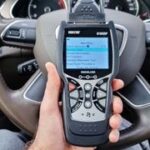Locating the OBD2 port in your car is the first step to performing a DIY diagnostic. For 2017 Hyundai Elantra owners, finding this port is straightforward, allowing you to easily connect a scanner and read valuable vehicle data. This article will guide you to the location of the OBD2 port in your 2017 Hyundai Elantra and explain its importance for vehicle maintenance.
Understanding the OBD2 port is essential for modern car owners. Since the OBD-II standard became mandatory in 1996, all vehicles, including the 2017 Hyundai Elantra, are equipped with a standardized 16-pin diagnostic connector. This port, also known as the Diagnostic Link Connector (DLC), allows mechanics and car owners to access the vehicle’s computer system to read diagnostic trouble codes, monitor sensor data, and perform various maintenance procedures.
The OBD2 port is designed to be located inside the passenger compartment of your vehicle. For the 2017 Hyundai Elantra, you can typically find the OBD2 port located beneath the dashboard on the driver’s side. Specifically, it is usually situated in the area above the pedals and below the steering column. You might need to crouch down and look under the dash to spot it. It’s often not immediately visible at eye level but is easily accessible once you know where to look. The port is a trapezoid-shaped, 16-pin female connector, and it is usually black, but can sometimes be other colors.
Why is it important to locate the OBD2 port in your 2017 Hyundai Elantra? This port is your gateway to understanding your car’s health. By connecting an OBD2 scanner to this port, you can:
- Read Diagnostic Trouble Codes (DTCs): When your check engine light illuminates, the OBD2 system stores codes indicating the problem. Scanning the OBD2 port allows you to retrieve these codes and understand the issue.
- Clear Check Engine Light: After addressing the problem, you can use a scanner to clear the trouble codes and turn off the check engine light.
- Monitor Real-Time Data: OBD2 scanners can display live data from your vehicle’s sensors, such as engine temperature, speed, RPM, and more. This data is invaluable for diagnosing issues and monitoring performance.
- Perform Emissions Testing: In many areas, emissions testing involves reading data from the OBD2 port to ensure your vehicle meets environmental standards.
- Enhance Vehicle Maintenance: Regular OBD2 scans can help you catch minor issues before they become major problems, contributing to preventative maintenance and saving you money in the long run.
Using an OBD2 scanner on your 2017 Hyundai Elantra is a simple process. Once you have located the port, simply plug in your scanner. Most scanners are user-friendly and will guide you through the process of reading codes or accessing live data. There are various types of OBD2 scanners available, from basic code readers to more advanced scan tools with enhanced features. Choose one that suits your needs and technical expertise.
In conclusion, the OBD2 port is a vital component for vehicle diagnostics and maintenance. For owners of a 2017 Hyundai Elantra, locating this port is a simple task, usually found under the dashboard on the driver’s side. By familiarizing yourself with the OBD2 port and utilizing a scanner, you can take a proactive approach to vehicle care, ensuring your 2017 Hyundai Elantra runs smoothly and efficiently for years to come. Remember to consult your vehicle’s owner’s manual for any specific details related to diagnostics and maintenance.
